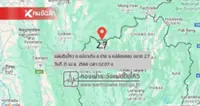
Mt. Kilang in Calanasan, Apayao. - Photo courtesy of the Apayao Provincial Tourism Services Office
MANILA: The Department of Tourism (DOT) has welcomed the recent inclusion of Apayao in the Unesco’s world network of biosphere reserves, which is the fourth in the Philippines to be recognised by the international body.
The Unesco approved the designation of 11 new biosphere reserves, including the Apayao Biosphere Reserve in the Philippines during the 36th session of the International Coordinating Council of the Unesco Man and the Biosphere Programme (ICC MAB) in Agadir, Morocco on July 5, 2024.
These new designations bring the World Network of Biosphere Reserves to 759 sites in 136 countries.
“The DOT extends its heartfelt congratulations to the province of Apayao for being recognised as the fourth ‘biosphere reserve’ in the Philippines by a body of the United Nations,” Tourism Secretary Christina Frasco said Friday (July 19).
“The recognition of Apayao by Unesco serves as a testament to the ecological importance and conservation efforts within the province.
"The Department of Tourism looks forward to collaborating with local stakeholders to further elevate sustainable tourism practices and promote the beauty of Apayao and the entire Philippines on the global stage,” she added.
Tagged as the “last frontier of Cordillera,” Apayao joins the provinces of Albay and Palawan, as well as the beach and dive spots of Puerto Galera in Oriental Mindoro, in the list of Unesco biosphere reserves.
Unesco created the Man and the Biosphere Programme to “enhance the relationship between people and their environments.”
Under the said program is the World Network of Biosphere Reserves or sites that “exemplify harmony between people and nature for sustainable development.”
Rich biodiversity, culture
According to the Apayao provincial government, its bid for the “biosphere reserve” recognition started after discovering the first active nest of the Philippine eagle (Pithecophaga jefferyi) within forests in Luzon.
The said discovery gave birth to the Apayao Lowland Forest Key Biodiversity Area, which “serves as a refuge for critically endangered species like the Philippine eagle,” said the Unesco in naming Apayao as one of the 11 new biosphere reserves for 2024.
It said the biosphere reserve in Apayao, one of the six provinces that make up the Cordillera Administrative Region or CAR, “spans 3,960 square kilometers.”
According to Unesco, Apayao’s biosphere reserve is composed of two regions: the Upper Apayao that exhibits “rugged terrain with towering peaks, plateaus, and valleys; and the Lower Apayao that features “flatlands adorned with rolling hills and plateaus.”
Also, the 180-kilometer Apayao River is one of the largest river systems in the Philippines and “serves as a vital watershed, nurturing 18 tributaries across the province,” added the UN body.
Among the tourist attractions in Apayao are mostly natural sites such as the Lussok Cave and Underground River and the wavy and sharp Dupag Rock Formations in the town of Luna, according to the Provincial Tourism Services Office.
The said office is also in the process of validating tourism sites in the province’s seven towns including waterfalls and nature-based tourism parks.
The province is also home to the ethnic Isneg community that practices until today the Lapat system, which according to studies, “prohibits” or “regulates” excessive use of natural resources led by the tribal leaders.
The DOT, for its part, said it remains committed to helping preserve the country’s destinations where flora and fauna thrive.
“The Department of Tourism remains committed to strengthening initiatives aimed at preserving the natural treasures of the Philippines noting that alongside the nation’s vibrant culture and rich heritage, the diverse natural landscapes play a pivotal role in establishing the Philippines as a distinctive and sought-after travel destination,” Frasco said.
As one of the 18 mega-biodiverse countries in the world, the Philippines is home to up to 80 percent of the world’s plant and animal species.
As a marine biodiversity hotspot, the Philippines is also home to more than 2,500 species of fish and 500 species of coral. - The Philippine Daily Inquirer/ANN









































